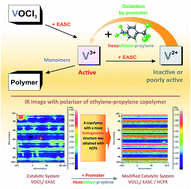The regularities of ethylene–propylene copolymerisation over a vanadium oxytrichloride (VOCl3)–ethylaluminium sesquichloride (EASC) catalytic system in the presence of hexachloro-p-xylene (HCPX), tert-butyl chloride, trichlorotoluene, hexachlorocyclopentadiene, and trichloroacetate were studied. The main kinetic regularities of ethylene–propylene copolymerisation when using HCPX were determined and the kinetic parameters of the process were obtained. It was shown that hexachloro-p-xylene is the most efficient promoter of polymerisation that increases activity of the “vanadium” catalyst severalfold and enhances propylene reactivity in its copolymerisation with ethylene. A number of molecular characteristics and physicochemical parameters were determined for the synthesised samples of ethylene–propylene copolymers. The resulting copolymers have a higher molecular weight and a broad molecular weight distribution and are richer in propylene monomers compared to the copolymers synthesised in the catalytic system without HCPX. Modification of the “vanadium” catalyst yields the copolymer with a more homogeneous structure. Assumptions were made about the mechanism of action of the promoter under study in the VOCl3–EASC catalytic system.

